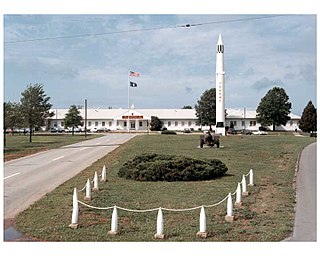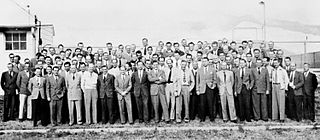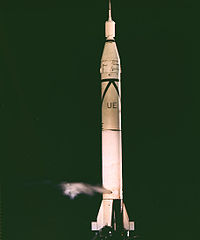
The Jupiter-C was an American research and development vehicle developed from the Jupiter-A. Jupiter-C was used for three uncrewed sub-orbital spaceflights in 1956 and 1957 to test re-entry nosecones that were later to be deployed on the more advanced PGM-19 Jupiter mobile missile. The recovered nosecone was displayed in the Oval Office as part of President Dwight D. Eisenhower's televised speech on November 7, 1957.

Redstone Arsenal (RSA) is a United States Army post and a census-designated place (CDP) adjacent to Huntsville in Madison County, Alabama, United States and is part of the Huntsville-Decatur Combined Statistical Area. The Arsenal is a garrison for various tenants across the Department of Defense, Department of Justice, and NASA. RSA has benefited from decisions by the Defense Base Realignment and Closure Commission. The Redstone Arsenal CDP had a residential population of 837 as of the 2020 census. The base contains a government and contractor workforce that averages 36,000 to 40,000 personnel daily.

The George C. Marshall Space Flight Center (MSFC), located in Redstone Arsenal, Alabama, is the U.S. government's civilian rocketry and spacecraft propulsion research center. As the largest NASA center, MSFC's first mission was developing the Saturn launch vehicles for the Apollo program. Marshall has been the lead center for the Space Shuttle main propulsion and external tank; payloads and related crew training; International Space Station (ISS) design and assembly; computers, networks, and information management; and the Space Launch System (SLS). Located on the Redstone Arsenal near Huntsville, MSFC is named in honor of General of the Army George C. Marshall.

The Army Ballistic Missile Agency (ABMA) was formed to develop the U.S. Army's first large ballistic missile. The agency was established at Redstone Arsenal on 1 February 1956, and commanded by Major General John B. Medaris with Wernher von Braun as technical director.

The PGM-11 Redstone was the first large American ballistic missile. A short-range ballistic missile (SRBM), it was in active service with the United States Army in West Germany from June 1958 to June 1964 as part of NATO's Cold War defense of Western Europe. It was the first US missile to carry a live nuclear warhead, in the 1958 Pacific Ocean weapons test, Hardtack Teak.

The Saturn family of American rockets was developed by a team of mostly German rocket engineers and scientists led by Wernher von Braun to launch heavy payloads to Earth orbit and beyond. The Saturn family used liquid hydrogen as fuel in the upper stages. Originally proposed as a military satellite launcher, they were adopted as the launch vehicles for the Apollo Moon program. Three versions were built and flown: the medium-lift Saturn I, the heavy-lift Saturn IB, and the super heavy-lift Saturn V.
The Saturn I was a rocket designed as the United States' first medium lift launch vehicle for up to 20,000-pound (9,100 kg) low Earth orbit payloads. The rocket's first stage was built as a cluster of propellant tanks engineered from older rocket tank designs, leading critics to jokingly refer to it as "Cluster's Last Stand". Its development was taken over from the Advanced Research Projects Agency in 1958 by the newly formed civilian NASA. Its design proved sound and flexible. It was successful in initiating the development of liquid hydrogen-fueled rocket propulsion, launching the Pegasus satellites, and flight verification of the Apollo command and service module launch phase aerodynamics. Ten Saturn I rockets were flown before it was replaced by the heavy lift derivative Saturn IB, which used a larger, higher total impulse second stage and an improved guidance and control system. It also led the way to development of the super-heavy lift Saturn V which carried the first men to landings on the Moon in the Apollo program.

The PGM-19 Jupiter was the first nuclear armed, medium-range ballistic missile (MRBM) of the United States Air Force (USAF). It was a liquid-propellant rocket using RP-1 fuel and LOX oxidizer, with a single Rocketdyne LR79-NA rocket engine producing 667 kilonewtons (150,000 lbf) of thrust. It was armed with the 1.44 megatons of TNT (6.0 PJ) W49 nuclear warhead. The prime contractor was the Chrysler Corporation.

The Rocketdyne H-1 was a 205,000 lbf (910 kN) thrust liquid-propellant rocket engine burning LOX and RP-1. The H-1 was developed for use in the S-I and S-IB first stages of the Saturn I and Saturn IB rockets, respectively, where it was used in clusters of eight engines. After the Apollo program, surplus H-1 engines were rebranded and reworked as the Rocketdyne RS-27 engine with first usage on the Delta 2000 series in 1974. The RS-27 variant is also used on the Delta II and Delta III.

The U.S. Space & Rocket Center in Huntsville, Alabama is a museum operated by the government of Alabama, showcasing rockets, achievements, and artifacts of the U.S. space program. Sometimes billed as "Earth's largest space museum", astronaut Owen Garriott described the place as, "a great way to learn about space in a town that has embraced the space program from the very beginning."
The Saturn Vehicle Evaluation Committee, better known as the Silverstein Committee, was a US government commission assembled in 1959 to recommend specific directions that NASA could take with the Saturn rocket program. The committee was chaired by Abe Silverstein, a long-time NASA engineer, with the express intent of selecting upper stages for the Saturn after a disagreement broke out between the Air Force and Army over its development. During the meetings the Committee members outlined a number of different potential designs, including the low-risk solution von Braun was developing with existing ICBM airframes, as well as versions using entirely new upper stages developed to take full advantage of the booster stage. The advantages of using new uppers were so great that the committee won over an initially skeptical von Braun, and the future of the Saturn program changed forever.

The United States Army Aviation and Missile Command (AMCOM) develops, acquires, fields and sustains aviation, missile and unmanned aerial vehicles. AMCOM is primarily responsible for lifecycle management of army missile, helicopter, unmanned ground vehicle and unmanned aerial vehicle weapon system. The central part of AMCOM's mission involves ensuring readiness through acquisition and sustainment support for aviation systems, missile systems, and test, measurement, and diagnostic equipment (TMDE) throughout their life cycle. The command is headquartered at Redstone Arsenal in Huntsville, Alabama, has a 2019 "budget of more $3.7 billion, and a global workforce of more than 15,000 military and civilian employees".

Ernst Stuhlinger was a German-American atomic, electrical, and rocket scientist. After being brought to the United States as part of Operation Paperclip, he developed guidance systems with Wernher von Braun's team for the US Army, and later was a scientist with NASA. He was also instrumental in the development of the ion engine for long-endurance space flight, and a wide variety of scientific experiments.

Konrad Dannenberg was a German-American rocket pioneer and member of the German rocket team brought to the United States after World War II.

The Saturn V dynamic test vehicle, designated SA-500D, is a prototype Saturn V rocket used by NASA to test the performance of the rocket when vibrated to simulate the shaking which subsequent rockets would experience during launch. It was the first full-scale Saturn V completed by the Marshall Space Flight Center (MSFC). Though SA-500D never flew, it was instrumental in the development of the Saturn V rocket which propelled the first men to the Moon as part of the Apollo program. Built under the direction of Dr. Wernher von Braun, it served as the test vehicle for all of the Saturn support facilities at MSFC.

The Redstone family of rockets consisted of a number of American ballistic missiles, sounding rockets and expendable launch vehicles operational during the 1950s and 1960s. The first member of the Redstone family was the PGM-11 Redstone missile, from which all subsequent variations of the Redstone were derived. The Juno 1 version of the Redstone launched Explorer 1, the first U.S. orbital satellite in 1958 and the Mercury-Redstone variation carried the first two U.S. astronauts into space in 1961. The rocket was named for the Redstone Arsenal in Huntsville, Alabama where it was developed.
The Mercury-Redstone Launch Vehicle, designed for NASA's Project Mercury, was the first American crewed space booster. It was used for six sub-orbital Mercury flights from 1960–1961; culminating with the launch of the first, and 11 weeks later, the second American in space. The four subsequent Mercury human spaceflights used the more powerful Atlas booster to enter low Earth orbit.
Heinz-Hermann Koelle was a German aeronautical engineer who made the preliminary designs on the rocket that would emerge as the Saturn I. Closely associated with Wernher von Braun's team at the Army Ballistic Missile Agency (ABMA), he was a member of the launch crew on Explorer 1 and later directed the Marshall Space Flight Center's involvement in Project Apollo. In 1965, he accepted the Chair of Space Technology at the Technical University of Berlin.

Hans Joachim Oskar Fichtner was a rocket scientist who worked on V-2 rockets for Wernher von Braun at Peenemünde from 1939 to 1945. He was among the scientists to surrender and travel to the United States to provide rocketry expertise via Operation Paperclip which took them first to Fort Bliss, Texas (1945–1949). He continued his work with the team when they moved to Redstone Arsenal, and he joined Marshall Space Flight Center to work for NASA.
Milton Kyser Cummings had a noteworthy career in two highly diverse fields: cotton broker and space-defense industry executive. Sometimes called the "Number One Citizen of Huntsville" and a "Symbol of the New South," he was recognized as a humanitarian, leader in opportunities for minorities and the handicapped, and advisor to government officials and congressmen. The Cummings Research Park, the second largest park of this type in America, was named to honor him.

























